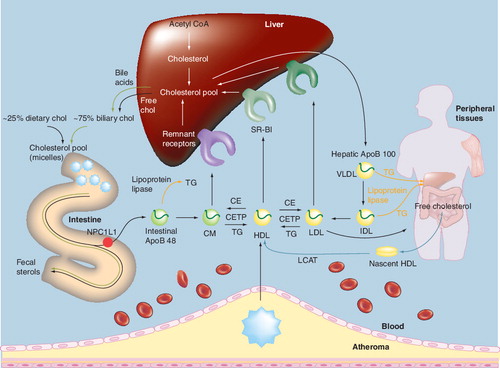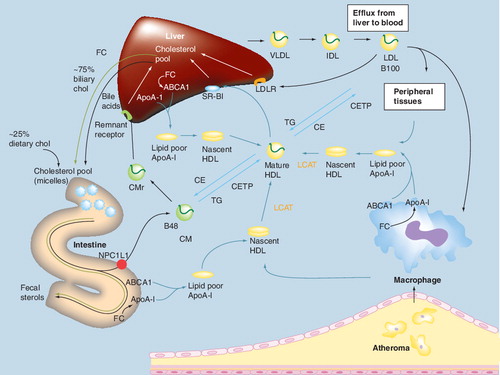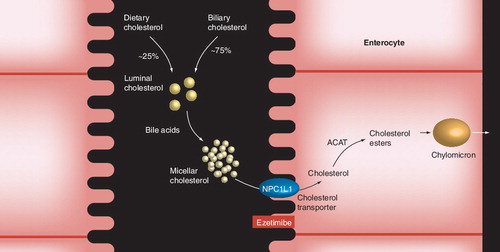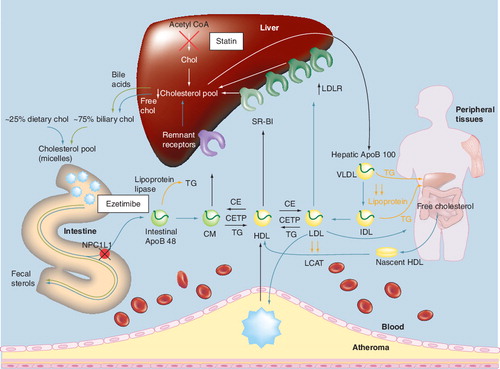Figures & data
ApoB: Apolipoprotein B; CE: Cholesterol ester; CETP: Cholesteryl ester transfer protein; chol: Cholesterol; CM: Chylomicron;
CMr: Chylomicron remnant; IDL: Intermediate-density lipoprotein; LCAT: Lecithin-cholesterol acetyltranferase; NPC1L1: Niemann–Pick C1-like 1 protein; SR-BI: Scavenger receptor type BI; TG: Triglyceride; VLDL: Very-low-density lipoprotein.

Adapted with permission from Citation[2].
![Figure 2. Hepatic cholesterol synthesis and lipoprotein packaging.Adapted with permission from Citation[2].](/cms/asset/219fe484-022c-480e-bb65-e2bfc20a3f38/ierk_a_11210377_f0002_b.jpg)
The esterification and lipoprotein packaging of cholesterol by the liver (hepatocyte) and intestine (enterocyte), occur intracellularly. Peripheral cholesterol transport via HDL particles occurs in the plasma.
ACAT: Acyl-CoA:cholesterol acyl transferase; CETP: Cholesteryl ester transfer protein; LCAT: Lecithin-cholesterol acyltransferase; MTP: Microsomal triglyceride transfer protein; VLDL: Very-low-density lipoprotein.
Reproduced with permission from Citation[2].
![Figure 3. Analogy of free cholesterol packaging into apolipoprotein B-containing lipoproteins in peripheral tissue, liver and intestine.The esterification and lipoprotein packaging of cholesterol by the liver (hepatocyte) and intestine (enterocyte), occur intracellularly. Peripheral cholesterol transport via HDL particles occurs in the plasma.ACAT: Acyl-CoA:cholesterol acyl transferase; CETP: Cholesteryl ester transfer protein; LCAT: Lecithin-cholesterol acyltransferase; MTP: Microsomal triglyceride transfer protein; VLDL: Very-low-density lipoprotein.Reproduced with permission from Citation[2].](/cms/asset/a3937dbc-aae4-4145-8035-e73a97d23e33/ierk_a_11210377_f0003_b.jpg)
ABCA1: Adenosine triphosphate-binding cassette transporter; ApoA-I : Apolipoprotein A-I; B100: Apolipoprotein B-100-containing lipoproteins; B48: Apolipoprotein B-48-containing lipoproteins; CE: Cholesterol ester; CETP: Cholesteryl ester transfer protein; CM: Chylomicron; CMr: Chylomicron remnant; FC: Free cholesterol; IDL: Intermediate-density lipoprotein; LCAT: Lecithin-cholesterol acyltransferase; LDLR: LDL receptor; NPC1L1: Niemann–Pick C1-like 1 protein; SR-BI: Scavenger receptor type BI; TG: Triglyceride; VLDL: Very-low-density lipoprotein.

ACAT: Acyl-CoA:cholesterol acyltransferase; NPC1L1: Niemann–Pick C1-like 1 protein.

ApoA-I: Apolipoprotein A-I; B100: Apolipoprotein B-100-containing lipoproteins; B48: Apolipoprotein B-48-containing lipoproteins; CE: Cholesterol ester; CETP: Cholesteryl ester transfer protein; chol: Cholesterol; CM: Chylomicron; CMr: Chylomicron remnant; IDL: Intermediate-density lipoprotein; LCAT: Lecithin-cholesterol acetyltransferase; LDLR: LDL receptor; NPC1L1: Niemann–Pick C1-like 1 protein; SR-BI: Scavenger receptor type BI; TG: Triglyceride; VLDL: Very-low-density lipoprotein.

*p < 0.05 versus placebo.
EZE: Ezetimibe.
Reproduced with permission from Citation[51].
![Figure 7. Dose–response effect of ezetimibe monotherapy.*p < 0.05 versus placebo.EZE: Ezetimibe.Reproduced with permission from Citation[51].](/cms/asset/0019f423-ddd6-4f6d-9094-a719edff1894/ierk_a_11210377_f0007_b.jpg)
*p < 0.001; **p < 0.05; ***p < 0.01.
HDL-C: High-density lipoprotein-cholesterol; LDL-C: Low-density lipoprotein-cholesterol; TG: Triglyceride.
Reproduced with permission from Citation[54].
![Figure 8. Ezetimibe add-on to statin therapy.*p < 0.001; **p < 0.05; ***p < 0.01.HDL-C: High-density lipoprotein-cholesterol; LDL-C: Low-density lipoprotein-cholesterol; TG: Triglyceride.Reproduced with permission from Citation[54].](/cms/asset/57b7b454-1c5e-4219-ba1f-9259f3d7450b/ierk_a_11210377_f0008_b.jpg)
*p < 0.001 EZE/SIMVA versus same dose SIMVA.
**p < 0.05 EZE/SIMVA versus same dose SIMVA.
‡p < 0.05 EZE/SIMVA versus next highest dose SIMVA.
EZE: Ezeteimibe; RLP-C: Remnant-like particle cholesterol; SIMVA: Simvastatin.
Adapted with permission from Citation[65].
![Figure 10. Effect of ezetimibe, simvastatin and ezetimibe/simvastatin on RLP-C.*p < 0.001 EZE/SIMVA versus same dose SIMVA.**p < 0.05 EZE/SIMVA versus same dose SIMVA.‡p < 0.05 EZE/SIMVA versus next highest dose SIMVA.EZE: Ezeteimibe; RLP-C: Remnant-like particle cholesterol; SIMVA: Simvastatin.Adapted with permission from Citation[65].](/cms/asset/638c8846-c6c1-4b2d-8c6f-94c3bca74598/ierk_a_11210377_f0010_b.jpg)
Adapted with permission from Citation[122].
![Figure 11. Cardiovascular disease risk factors and association with phytosterols and cholesterol synthesis precursors.Adapted with permission from Citation[122].](/cms/asset/484a53f9-0697-490d-8347-788693d0886a/ierk_a_11210377_f0011_b.jpg)
* p < 0.001 versus placebo.
‡p < 0.001 versus pooled SIMVA.
§p < 0.05 versus EZE.
¶p < 0.001 versus EZE.
#p < 0.001 versus pooled ATORVA.
ATORVA: Atorvastatin; EZE: Ezetimibe; SIMVA: Simvastatin.
Adapted with permission from Citation[129].
![Figure 12. Ezetimibe and statin effect on phytosterol concentrations.* p < 0.001 versus placebo.‡p < 0.001 versus pooled SIMVA.§p < 0.05 versus EZE.¶p < 0.001 versus EZE.#p < 0.001 versus pooled ATORVA.ATORVA: Atorvastatin; EZE: Ezetimibe; SIMVA: Simvastatin.Adapted with permission from Citation[129].](/cms/asset/01c7e0f0-c7cf-47a3-b1e5-52ab21cd9295/ierk_a_11210377_f0012_b.jpg)
*p < 0.001 versus placebo.
‡p < 0.05 versus placebo.
§p < 0.05 versus EZE.
¶p < 0.001 versus EZE
ATORVA: Atorvastatin; EZE: Ezetimibe; SIMVA: Simvastatin.
Adapted with permission from Citation[129].
![Figure 13. Ezetimibe and statin effects on cholesterol precursors.*p < 0.001 versus placebo.‡p < 0.05 versus placebo.§p < 0.05 versus EZE.¶p < 0.001 versus EZEATORVA: Atorvastatin; EZE: Ezetimibe; SIMVA: Simvastatin.Adapted with permission from Citation[129].](/cms/asset/d8eeb0fd-a86f-4ae6-8403-d39ac48077a7/ierk_a_11210377_f0013_b.jpg)
